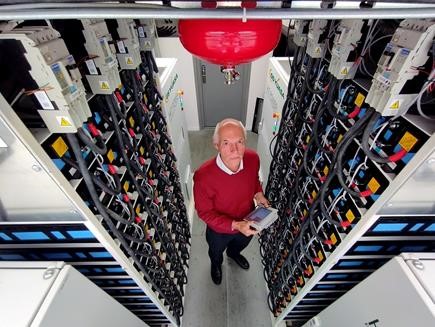GS Yuasa batteries playing key role at Royal Mint Energy Centre
 Photo: GS Yuasa
Photo: GS Yuasa
Battery technology specialist GS Yuasa has played a pivotal role in powering the future of sustainable energy at The Royal Mint’s multi-technology Energy Centre at Llantrisant, Wales, which was unveiled by Infinite Renewables earlier this month. At the heart of The Royal Mint Energy Centre is GS Yuasa’s state-of-the-art dual-chemistry energy storage system (ESS).
This system uniquely combines 1,120 50Ah LIM50EL lithium-ion cells known for their rapid discharge and quick response capabilities, with 240 1000Ah SLR1000 lead-acid cells, which are prized for their longevity and robustness in prolonged energy provision. Housed in two separate containers, this setup is designed to ensure optimal energy distribution: the lithium-ion batteries are predominantly utilised until they are discharged to 20 per cent, at which point the lead-acid batteries take the lead, with their current rising swiftly to complement and support the energy demands. GS Yuasa says this blend of the two chemistries represents the “peak of current battery technology,” harnessing the strengths of both types to deliver an unparalleled power solution for power shifting and energy distribution.
The world’s first EES of this type was installed at the Japanese-based global battery manufacturer’s manufacturing plant, situated a stone’s throw away in Ebbw Vale, where a combination of wind turbines, 3,000 solar panels and battery storage provide reliable and cost-efficient green power to the factory.
Sustainability front & centre
“Our dual-chemistry system represents the latest in sustainable battery technology. It offers not just power but also ensures efficiency and sustainability in meeting the energy demands of major institutions like The Royal Mint,” states Peter Stevenson, senior technical coordinator at GS Yuasa Battery Europe.
The Royal Mint has a history spanning over 1,100 years. Established originally to produce coins for England, it has since evolved into the world’s leading mint, manufacturing coins, currency, and medals for an array of countries. The Energy Centre, which comprises of a 2 MW solar farm, two wind turbines and a combined heat and power (CHP) unit along with GS Yuasa’s ESS, is designed to provide approximately 75 per cent of The Royal Mint’s energy needs and holds the potential to supply a microgrid connected to adjacent businesses.
“Sustainability is front and centre in all we do as a business and this is another exciting step in The Royal Mint’s sustainability journey, helping us towards our goal of becoming net zero by 2050,” comments Inga Doak, head of sustainability at The Royal Mint.




Comments